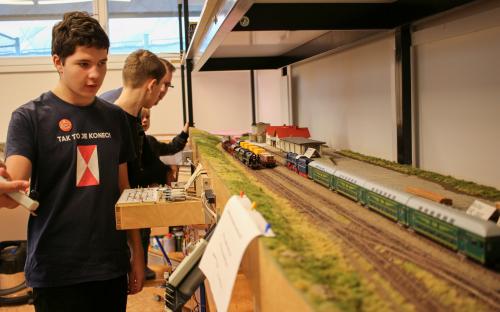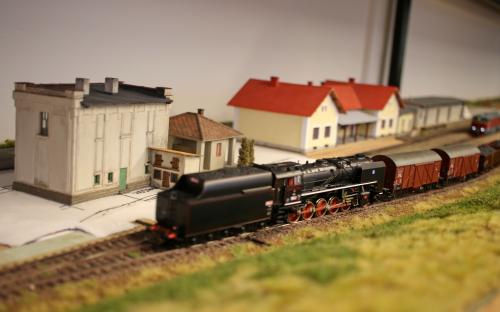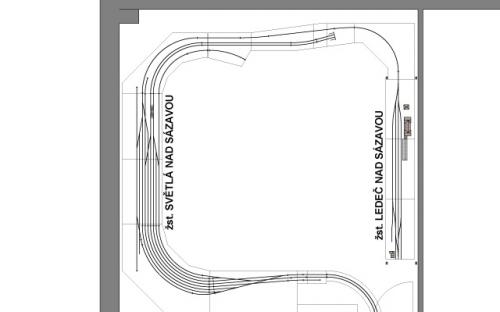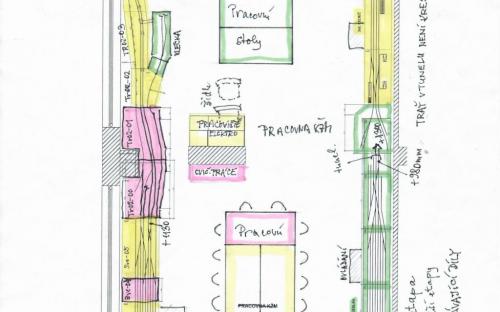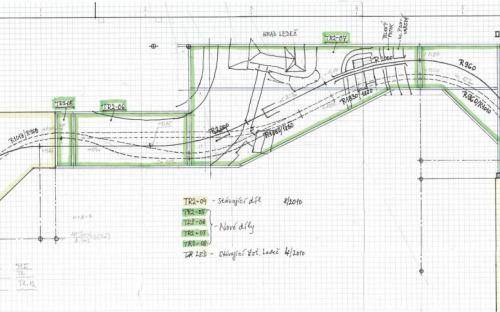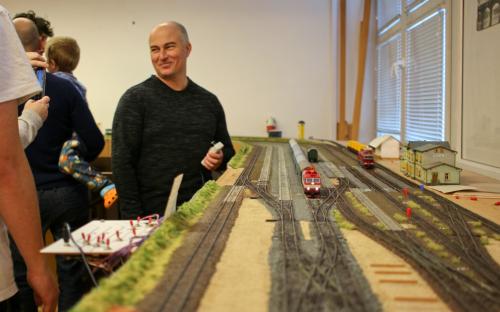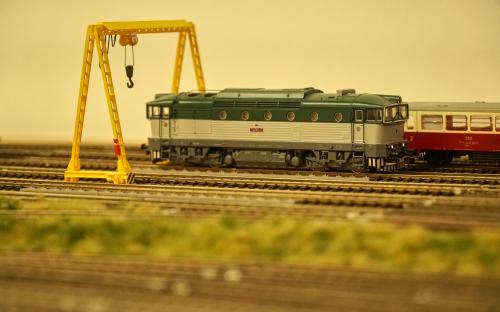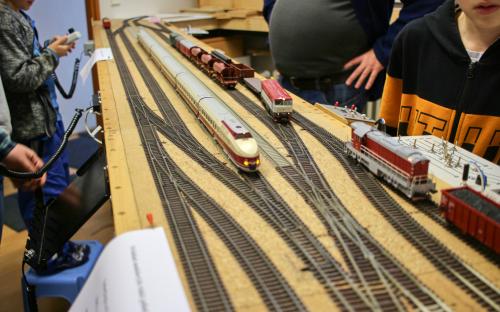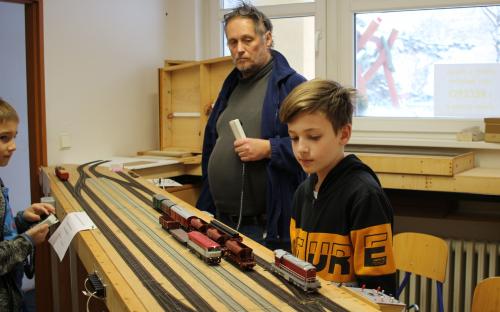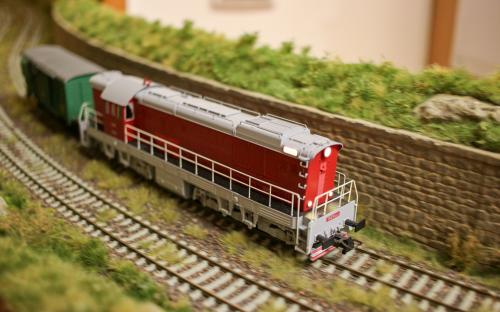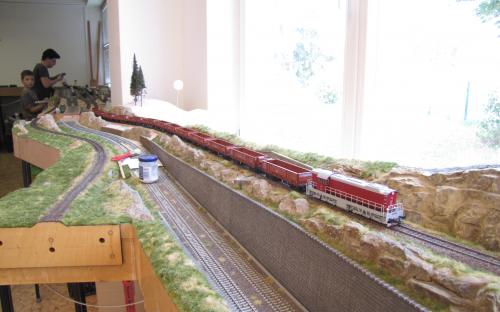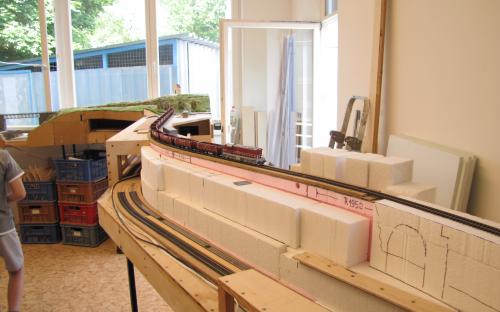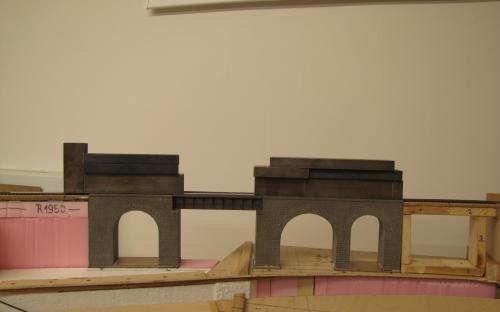Pro přečtení celého článku klepněte levým tlačítkem myši na jeho nadpis...
Group of railway modellers in Prague 4 - English abstract
We are a group of railway modelers under the Children's and youth center Prague 4 "Hobby centrum 4". In this article, we provide information about the establishment of our group of railway modelers, about building of our model railway layout, about our work in the childrens' groups, and about biulding the equipment of our workroom. Unfortunately, it is not within our power to translate the entire content of our website, so we only present a brief abstract.
To continue reading click the heading of this article...
FOUNDATION OF OUR GROUP
Our model railway group was founded in 2007. In the beginning, I led only one group of younger children and I lent them a small home model railway layout that I had originally built for my son. Today we run a total of 6 childrens' groups, one for the smallest children (8 to 10 years), three for beginners (from 10 years) and two for advanced and adults (from 12 years). We now work in two group leaders and have only a very small network of adult collaborators. That's why our work on the model track layout is slow. It is also because we try to work in such a way that the results of our work pleased us and we did not have to be ashamed of them.
We started with a small borrowed home layout, but soon, thanks to our work, we convinced our management that an institution like "Hobby center 4" needs a model railway layout of a dignified size and design that would attract children from a wide area. This decision bore fruit, so today we are the largest childrens' model railway club in Prague in terms of the number of children in our groups. Children come to us even from opposite ends of Prague. However, I have to admit that the railway modellers y have the largest track layout at the technicians' station in Prague 6 Pod Juliskou.
In the 15 years of the existence of our railway model group, we have brought up a number of boys who are already adults today. Some of them work with Czech Railways. Several of them have remained with us to this day and help us build a track or show younger pupils how to do their training modeling work.
BUILDING OF OUR MODEL RAILWAY
In 2008, we were allocated a 6x6 meter room, which was expanded to double the size in 2020. Since 2009, we have been gradually building a large track yard in H0 size with a two-track main line and a small local track. We are planning 4 stations in total, we are currently operating 3 stations. After expanding our workroom in 2020, we extended the interstation sections of the tracks and started building a fourth station. Unfortunately, we are growing slowly, because we do all the work with our own and the only time suitable for dusty work in the construction of frames of new parts of our track layout are summer holidays when the layout is not in operation. We plan a total of about 62 meters of tracks (including the length of stations). We will have a total of about 220 meters of tracks and around 80 switches. Now we run about 35 meters of tracks and we have additional 18 meters of double-track line, which we put into operation together with the station Čáslav, which is now being built.
We build the tracks according to real stations and lines. The subject of our work is the main line between Havlíčkův Brod and Čáslav with the branch station Světlá nad Sázavou, where the local train branches off to Ledeč and Čerčany. We are trying to build the Ledeč station exactly according to real station and if it weren't for shorter switches (Tillig Elite W3 - 9°) it would be long just according to reality. We are building the station Brod and Čáslav (on both ends of the main line) as hidden stations, which in our conditions means normally accessible stations from above, but without modeled details. These stations serve to supply our lines and stations with interesting trains. We are trying to build the Světlá central station exactly according to the real Světlá nad Sázavou station, but it is very difficult. The actual station is around 1200 meters long between the edge switches, which would be 14 meters on the model. We could not afford such a large station, especially since we started building it at a time when our room was only 6x6 meters. Therefore, we had to shorten the station to its current length of 7 meters and also bend it into an arch. One station header corresponds almost exactly to reality, while the other header we had to modify according to our imagination. In addition, there the tracks going from the station go to the vestibule (to Brod station) and therefore due to the track arch they are relatively far from the wall. That's why we placed a locomotive depot in this space at Světlá station (contrary to reality). If we talk about track arches, we try to make them with a radii from 1000 mm up to 3000 mm. Unfortunately, due to the cramped space in which we build the track, this is not always possible. Thus, in one part of a local track we have a radius of 880 mm, and unfortunately only 800 mm on the main line in front of Brod station and even only 600 / 550 mm inside Brod station at the entrance to the group of sidings. This is due to the layout of the rooms available to us.
SEGMENTS OR MODEULES?
The wooden frames of the segments of our track are built from blockboard and plywood on their upper side. Individual frames are connected using precision bolts and precision bushings. Therefore, our track is not modular, but is built from segments that can be connected in only one way (i.e. screwed together with precise bolts through precise bushings). However, our three-part Ledeč station can become a five-part module after adding two peripheral segments (called Jokers) with an interface for the modular railway. As modules, we also plan to modify our hidden stations Brod and Čáslav in the same way.
LEADING THE CHILDREN AND THEIR MODELLING JOBS
Of course, children love the operation of the model railway the most, but we also teach them the necessary theory so that they can handle the model operation according to the real railway well. In our childrens' groups, for example, the children operate a telephone offer of trains (between stations), and until we set up and work light signals, they use hand signals. Of course, we do practice modeling exercises with the children, such as small dioramas with a track and a rock or with a track and a bridge and the like. Older and advanced children already work independently on dioramas of their own design. We display nice and interesting works in our showcase, but everyone can take his practice works home sooner or later. The most skilled of the children can work on the modifications and improvement of our track layout. There is a lot of jobs for them: forming parts of the landscape from polystyrene foam, casting and coloring plaster rocks, grassing the landscape, graveling the tracks and building model houses according to real models, and lot of other modeling jobs.
JOBS FOR THE LEADERS
Of course there remains a lot of precise craft work that have to be done mostly before modeling the landscape. And that is left to the leaders, or to their assistants, if they have any at the time of need. I speak about building the wooden frames of the individual track segments as well as most of the custom-made furniture for our workroom I had to make according the shape of our planned track layout. I'm an electrical engineer, but I felt like a carpenter while building the track segment frames and furniture for our workroom.
In the same way, the adults did the welding of the steel structures of the furniture racks, the connection of individual parts of the track segment to precise steel bushings and bolts, as well as the construction of track bodies and the laying of tracks in precise geometry. All these carpentry and locksmith jobs (as well as laying the tracks and switches) had to be done precisely, so that later the trains run as reliably as possible.
ELECTRICAL AND OTHER SPECIAL JOBS
I haven't talked about the electrical installation of our track layout yet. We have digital locomotives, most of them with sound. We control them in the same way as FREMO or Zababov club, i.e. using FRED or FREDi locomotive controllers and SPAX boosters. We are currently preparing the control of the Světlá central station with an industrial control system, which should emulate the relay security system of the station. These jobs were put on hold after the expansion of our workshop in 2020, when I had to make 16 new segment frames and lay the tracks on them and at the same time make 12 new furniture cabinets and a large shelf for storing modeling material. I am now very slowly returning to my original jobs and I hope to return to task algorithmization and control system programming soon as well.
We have divided track electrical circuits to identify track occupancy, I have developed a track occupancy detection circuit, a driver for controlling American Tortoise turnouts by transistor arrays, a circuit for automatic turntable track polarity reversal, several electrical sources and others. For these circuits and for the connectors at the interface of the layout segments, my fellow leader Zdeněk Valter (using the Eagle program) designed and ordered printed circuit boards from China. In addition, we started building our own light signals. One of our older members (an industrial student) is proficient in Corel Draw, so he started designing brass plate etchings for these light signals. We bought a 3D printer, so Zdeněk immediately set about 3D printing the plinths for the light signals into which the printed circuit board with the connector and with resistors for the LEDs and will be inserted. 3D printing is a universal technology that allowed us to create a number of things in a short time, e.g. a holder for an infrared reflective optocoupler to reverse the polarity of a turntable, a new beam model for an ash crane for a locomotive depot, concrete sewer pipes, and much more. As the leader of the group of modellers in Hobby Center 4, I have recently been dividing the work among the people more than working, modeling and programming myself. But fortunately, our progress is accelerating.
What to say in conclusion? We are slowly building our track layout because we don't want to spoil anything, and we are happy when it works well and reliably. We operate our model railway almost every meeting of our modeling club every week. But twice a year we hold a big meeting of the members of all our childrens' groups with the operation of our whole model railway. We put in the operation also the parts of our layout outside our workroom. Childrens' shining eyes are our reward.
Aleš Trdý
Leader of the young railway modelers
Hobby centrum 4, Bartákova 1200, 14000 Praha 4, Czech Republic
ales.trdy12@gmail.com
- Provoz kroužku:

